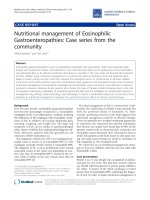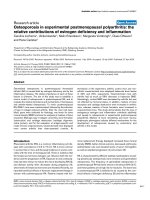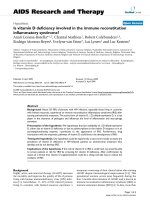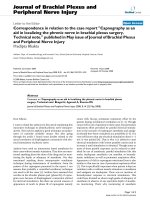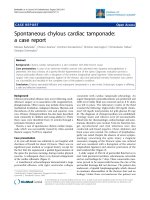Báo cáo y học: "Pica in iron deficiency: a case series" pptx
Bạn đang xem bản rút gọn của tài liệu. Xem và tải ngay bản đầy đủ của tài liệu tại đây (266.18 KB, 3 trang )
CAS E RE P O R T Open Access
Pica in iron deficiency: a case series
Yasir Khan
1,2
, Glenn Tisman
1*
Abstract
Introduction: Pica is an unusual condition where patients develop cravings for non-nutritive substances that can
cause significant health risks. We report three patients with pica, two of them showing evolutionary changes
associated with pica and the third demonstrating a peculiar nature of pica, which has yet to be reported.
Case presentation: We describe three patients who presented with symptoms of pica. The first patient is a 36-
year-old Caucasian woman who had dysfunctional uterine bleeding associ ated with daily ingestion of two super-
sized cups of ice as iced tea. The second patient is a 62-year-old Caucasian man who presented with bleeding
from colonic polyps associated with drinking partially frozen bottled water. Lastly, the third patient, a 37-year-old
Hispanic woman, presented with dysfunctional uterine bleeding and habitually chewed rubber bands. All three
patients presented with hematological parameters diagnostic for iron deficiency anemia.
Conclusion: Pica has been practiced for centuries without a clear etiology. We have noticed that the younger
community of academic and community physicians are not aware of the importance of complaints related to pica.
None of our patients we describe here, as well as their primary care physicians, were aware of the importance of
their pica related symptoms.
Pica symptoms abated in one of our patients upon iron supplementation, while the other two ar e currently under
treatment as of this writing. We believe pica is an important sign of iron deficiency that should never be ignored,
and the craving for any unusual substance should compel clinicians to search for occult blood loss with secondary
iron deficiency.
Introduction
Pica is an unusual craving for and ingestion of either
edible or inedible substances. The condition has been
described in medical journals for centuries [1-3]. One
of the first cases of pica was noted in 6th century AD
and was observed in a pregnant woman [1]. Since
then, many cases of pica have been reported where
patients have acknowledged ingesting ice cubes (pago-
phagia), clay (geophagia), dried pasta (amylophagia),
chalk, starch, paste, Kayexalate resin (resinphagia),
tomatoes, lemons, cigarette butts, hair, lead, and laun-
dry starch (for example, Argo out of the box) [1-7].
Although pica is most prominent in individuals with
developmental disabilities, it has been observed in
men and women of all ages and ethnicity, but is more
prevalent among the lower socioeconomic classes
[3,4]. Worldwide, 25% to 33% of all pica cases involve
small children, 20% are pregnant women, and 10% to
15% are individuals with learning disabilities [8]. A
small percentage of patients have iron deficiency
anemia.
Pica poses significant health risks that often require
medical interventions. These patients are susceptible to
electrolyte and metabolic disorders, lead and mercury
poisoning, hypokalemia (from resinphagia), parasitic
infections, tooth wear, intestinal obstruction, and various
problems of the gastrointestinal tract [3,6-9]. The exact
etiology of pica remains unclear, but it is significantly
associated with iron deficiency anemia [1,2,6,8-10].
When associated wi th iron deficie ncy, most physicians
believe that pica is an effect rather than a cause [2,10].
Surprisingly, we found that the majority of primary
care physicians are unaware of pica symptoms. Over a
period of 30 years, our group has evaluated a monthly
average of one to two patients with iron deficiency. We
have also noted that although the inges tion of excessive
amounts of ice (pagophagia) is an unusual symptom, its
presence has invariably been associat ed with documen-
ted cases of iron deficiency anemia.
* Correspondence:
1
Department of Medical Oncology, Whittier Cancer Research Building, Bailey
Street, Whittier, California, 90601, USA
Khan and Tisman Journal of Medical Case Reports 2010, 4:86
/>JOURNAL OF MEDICAL
CASE REPORTS
© 2010 Khan and Tisman; licensee BioMed Central Ltd. This is an Open A ccess article distributed under the terms of the Creative
Commons Attribution License ( ), which permits unrestricted use, distribution, and
reproduction in any medium, provided the original work is properly cited.
Here we present three patients who demonstrated
subtle changes in pica associated with iron deficiency.
We believe that this was due to advances in technology
and changing cultural customs. Each patient fully meets
the criteria for pica from Diagnostic and Statistical Man-
ual of Mental Disorders [5] and suffered from severe
iron deficiency anemia.
Case presentation
Our first patient is a 36-year-old Caucasian woman with
dysfunctional uterin e bleeding. She has experien ced
unusually heavy periods of bleeding for 12 months prior
to her presentation to our medical facility. Her heavy
bleeding required approximately two boxes of tampons
for every month of her menstrual cycle. Her hemoglobin
level was 10.2 g/dl, mean corpuscular volume (MCV)
was 68 fl and serum ferritin was 8 ng/ml. Her peripheral
blood smear revealed poikilo and microcytosis. When
asked about ice-cube eating, she stated that she drank
and sucked ice cubes from at least two super-sized
McDonald’s cups filled with i ce on a daily basis . The ic e
was part of a super-sized tea.
Our second patient is a 62-year-old Caucasian man
who presented with bleeding from colonic polyps. His
hemoglobin level was 8 g/dl and his serum ferritin was
11 ng/ml. His Wright-Giemsa-stained peripheral blood
smears revealed anisocytosis with microcytosis, which
was characteristic of iron deficiency. He claimed to
drinking extremely cold water. He would place his
bottledwaterinthefreezersothatitwouldforman
adherent patch of ice that encompassed the container,
thus reducing its temperature. He would drink his iced
water from three to four of these containers daily, b ut
he denied eating ice cubes. He underwent colonoscopic
polypectomy and iron replacement t herapy. His craving
for cold bottled water abated within two months of
therapy.
Our third patient is a 37-year-old Hispanic woman
with dysfunctional uterine bleeding for approximately
one year. Her hemoglobin level was 7 g/dl, MCV was
64 fl and serum ferritin was 4 ng/ml. Her peripheral
blood smear revealed anisocytosis and poikilocytosis
with microcytosis. This patient had been chewing rubber
bands for at least six months prior to dilation and curet-
tage. When asked to be specific, she stated that she
would chew three or four thin, preferably cream-colored
rubber bands con tinuously throughout the day. We
were surprised to see that she brought her favorite rub-
ber bands to the hospital so she could resume chewing
after she had awakened from anesthesia.
Discussion
Although observed since antiquity, pica remain s a mys-
terious and fascinating occurrence. It seems to be
strongly associated with iron deficiency anemia, and in
the majority of cases the unusual eating and chewing
behavior disappears upon iron supplementation
[1,6,10,11]. Several hypotheses exist about why iron defi-
ciency causes pica, including ph ysiological mechanisms;
however, there is no single agreed upon explanation
[1,4]. Pica has been linked to factors of age, gender, reli-
gion, culture, nutritional deficiency, stress, and mental
development [4]. When associated with iron deficiency,
it is believed to be a symptom of the deficiency rather
than its cause [2,10]. Occasionally, pic a practices cause
other nutritional deficiencies such as hypokalemia (clay
and Kayexalate ingestion [8,12]).
We pre sent these cases because they represent subtle
changes in the classical symptom complexes of pica.
This may probably be the result of advances in technol-
ogyandchangesinculture.Wheninitiallydescribed,
pago phagia was defined as the excessive ingestion of ice
cubes from ice trays and the ingestion of ice scraped
from the wall of the freezer [1]. With the advent of ice
cube makers and auto defrosters, the presentation of
pagophagia has changed in a subtle manner as described
in two of our patients. Now we obser ve a subtler inges-
tion and/or sucking of ice cubes from large super-sized
McDonald’ s-like cups and from the use of popular
bottled water containers that have been frozen. More-
over, the third patient we describe is the first report of
rubber band chewing as a manifestation of iron defi-
ciency anemia. Recently, Hackworth and Williams pre-
sented three cases where patients with sickle cell anemia
readily ingested foam rubber, and Kushner et al. pre-
sented two cases where patients developed pagophagia
after gastric bypass surgery [2,5].
Since iron deficiency may cause glossal pain, it has
been proposed that patients with anemia choose to
chew ice for its analgesic properties; however, rubber
bands and foam do not have any known analgesic prop-
erties [10]. There have been several theories explaining
the causes of pica. Earlier investigators proposed that
pica practices compensated for nutritional deficiencies,
such as iron or zinc, but this idea was discarded as ice,
rubber, foam and several other items, consumed by
those who practice pica, do not have any known nutri-
tional value. Other theories suggest possible psychoso-
cial problems, family stress, obsessive-compulsive
disorders, or merely the enjoyment of taste and texture
(the crunch of Argo starch out of the box or of clay
cookies) of the item being consumed [12].
Interestingly, pica is practiced when a patient is least
supervised. Patients are also secretive of their pica habits
and are often reluctant to mention it. Pica sympto ms
will thus go unnoticed unless the physician specifically
addresses them [ 2,13,14]. All t hree of our patients, as
well as their primary care physicians and academic
Khan and Tisman Journal of Medical Case Reports 2010, 4:86
/>Page 2 of 3
supervisors, were unaware of the symptoms of pica and
what these represented.
Earlier diagnosis of pica can prove beneficial especially
in the presence of an occult, bleeding malignancy or if
the patient is pregnant [2]. Pica in pregnancy is not
uncommon and, if unnoticed, may put both the mother
and fetus at risk [3,15].
Conclusion
We hope that this report reminds physicians of the
importance and diagnostic utility of pica symptoms
associated with iron deficiency, as well as t he evolution
of its symptoms as a result of changing technology and
culture.Inthepresenceofpica,thephysicianisobli-
gated to evaluate the patient for occult bloo d loss and
iron deficiency.
Consent
Written informed consent was obtained from our
patients for publication of t his case report a nd any of
the accompanying images. A copy of the written consent
is available for review by the Editor-in-Chief of this
journal.
Author details
1
Department of Medical Oncology, Whittier Cancer Research Building, Bailey
Street, Whittier, California, 90601, USA.
2
St Georges University School of
Medicine, Grenada, West Indies.
Authors’ contributions
GT is the consulting hematologist of our patients reported, was responsible
for the general scope and ideas for the research, and contributed in writing
the manuscript. YK conducted the literature research study and wrote the
manuscript under the guidance of GT. Both authors read and approved the
final manuscript.
Competing interests
The authors declare that they have no competing interests.
Received: 22 October 2009 Accepted: 12 March 2010
Published: 12 March 2010
References
1. Coltman CA: Pagophagia and iron lack. JAMA 1969, 207(3):513-516.
2. Kushner RF, Gleason B, Shanta-Retelny V: Reemergence of pica following
gastric bypass surgery for obesity: a new presentation of an old
problem. J Am Diet Assoc 2004, 104:1393-1397.
3. Grotegut CA, Dandolu V, Katari S, Whiteman VE, Holtzman OG, Teitelman M:
Baking soda pica: a case of hypokalemic metabolic alkalosis and
rhabdomyolysis in pregnancy. Obstet Gynecol 2006, 107:484-486.
4. Grivetti LE: Culture, diet and nutrition: selected themes and topics.
BioScience 1978, 28(3):171-177.
5. Hackworth SR, Williams LL: Pica for foam rubber in patients with sickle
cell disease. South Med J 2003, 96 :81-83.
6. Kathula SK: Craving lemons: another form of pica in iron deficiency. Am J
Med 2008, (clinical communication to the editor).
7. Tisman G: Resinphagia. N Engl J Med 1970, 283(11):602.
8. Barker D: Tooth wear as a result of pica. Br Dent J 2005, 199:271-273.
9. Karnath BM: Anemia in the adult patient. Hospital Physician 2004, 32-36.
10. Kettaneh A, Eclache V, Fain O, Sontag C, Uzan M, Carbillon L, Stirnemann J,
Thomas M: Pica and food craving in patients with iron deficiency
anemia: a case-control study in France. Am J Med 2005, 118(2):185-188.
11. Pagophagia and Anemia. Nutrition Reviews 1969, 27(2):52-54.
12. Ukaonu C, Hill A, Christensen F: Hypokalemic myopathy in pregnancy
caused by clay ingestion. Obstet Gynecol 2003, 102(5):1169-1171.
13. Falcomata TS, Roane HS, Pabico RR: Unintentional stimulus control during
the treatment of pica displayed by a young man with autism. RASD
2007, 350-359.
14. Scully RE, Mark EJ, McNeely WF, Ebeling SH: Case records of the
Massachusetts General Hospital: case 37-1998. N Engl J Med 1998,
339(24):1766-1772.
15. Lopez LB, Langini SH, Pita de Portela ML: Maternal iron status and
neonatal outcomes in women with pica during pregnancy. Int J Gynecol
Obstet 2007, 98:151-152.
doi:10.1186/1752-1947-4-86
Cite this article as: Khan and Tisman: Pica in iron deficiency: a case
series. Journal of Medical Case Reports 2010 4:86.
Submit your next manuscript to BioMed Central
and take full advantage of:
• Convenient online submission
• Thorough peer review
• No space constraints or color figure charges
• Immediate publication on acceptance
• Inclusion in PubMed, CAS, Scopus and Google Scholar
• Research which is freely available for redistribution
Submit your manuscript at
www.biomedcentral.com/submit
Khan and Tisman Journal of Medical Case Reports 2010, 4:86
/>Page 3 of 3




